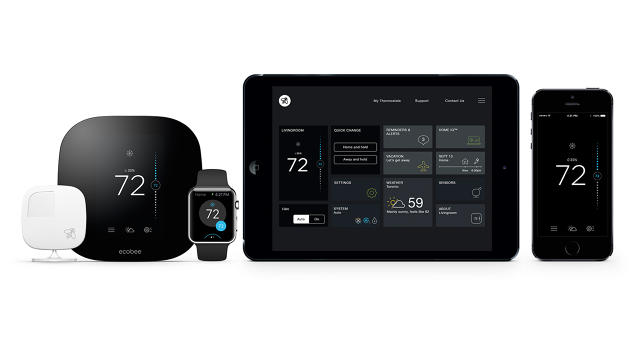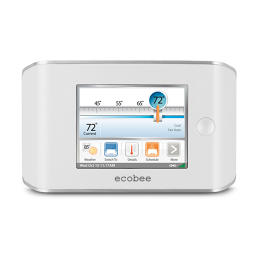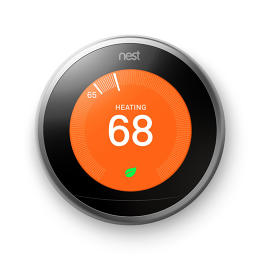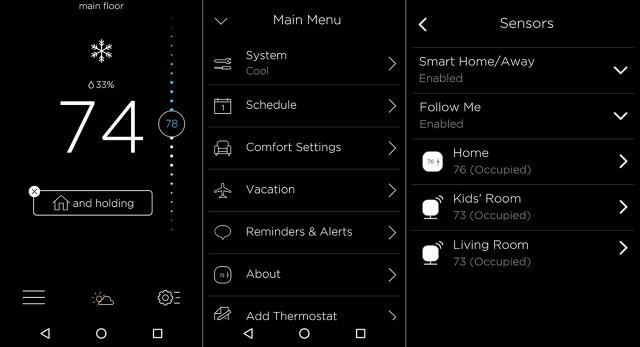Beyond Thermostats: Ecobee Dreams Of Being A Billion-Dollar Smart Home Giant
For the last nine years, Ecobee hasn’t strayed from being a maker of smart thermostats.
Unlike rival Nest, Ecobee never built its own smart home platform, and hasn’t expanded into new product categories. The $170 Ecobee3 Lite, announced last week, is the company’s first new hardware in two years, and it’s just a budget variant of the existing Ecobee3, ditching room sensor support while knocking down the price by $80.
So far, the singular focus has served Toronto-based Ecobee well. Thermostats are the most popular type of self-installed smart home devices, according to The NPD Group, and Ecobee—whose revenues have been doubling every year—is not far behind Nest in sales. Ecobee hopes to reach first place in 2017.

But Ecobee President and CEO Stuart Lombard says the company is also widening its ambitions. Instead of pegging itself as a thermostat maker, Ecobee wants to become a leader in the larger—but still nascent—connected home business. It’s a tall order for a company with no platform of its own, working in what might be an overhyped corner of the tech industry. But Lombard is optimistic, setting a goal of $1 billion in revenues by 2020.

“When you think about companies like Google, Microsoft, Amazon—those are phenomenal companies. We would like to be considered in the same breath as those companies,” Lombard says. “We understand we’ve got a ways to go.”
Cranking Up The Heat
Lombard and Mark Malchiondo, Ecobee’s vice president of software development, founded the company in 2007, with the idea to help people consume less energy and save money. They gravitated toward heating and cooling, which can gobble up more than half of home energy use, and toward thermostats in particular.
“In 2007, if you had a programmable thermostat, they were impossible to use, dumb as a doorknob, not internet-connected,” Lombard says.
The original Ecobee Smart thermostat launched in early 2009, promising to save energy while letting users control their home temperature by smartphone. But the device was pricey at $385, and aside from its resistive touch panel, it didn’t look like a major departure from the dull white rectangles adorning most walls.

Like the rest of the thermostat industry, Ecobee was caught snoozing by Nest, which arrived in 2011 with a much slicker smart thermostat for just $250. Nest was quickly acquired by Google and became the smart thermostat leader, while Ecobee spent a few years revamping its hardware. (Honeywell, the old guard of the thermostat business, also entered the smart home fray a few years ago with its Lyric devices.)
The Ecobee3, which launched in 2014 for $250, was a major improvement, with a jet black finish, capacitive touch screen, and room sensors that can adjust a home’s heat or air conditioning based on occupancy and temperature. Those room sensors—one of which is included in the box—are the Ecobee3’s biggest selling point compared to Nest and Honeywell Lyric.
But instead of just competing on features, Ecobee is now trying to undercut its rivals with the Ecobee3 Lite. “We believe that we’re going to deliver feature parity with Nest at a $169 price point—$80 less than Nest,” Lombard says.
What’s to stop Nest and Honeywell from lowering their prices? Nothing, really. But Rahul Raj, Ecobee’s vice president of marketing, counters that neither rival has bothered to introduce room sensors, even though focus groups have shown hot and cold zones to be a well-known issue for homeowners. The same goes for demand for an entry-level product. Surely, Raj says, Nest and Honeywell have heard the same customer requests that Ecobee has, yet they haven’t responded.
“Everyone always has the option,” Raj says, “but not everyone acts.”
Meanwhile, Lombard suggests that Ecobee will try to widen the feature gap with its flagship product in the future. “We’re going to take that dividend that we got from cost savings and we’re going to invest that in all kinds of great new technology that we’re going to put back into the product, and have feature superiority to Nest and Honeywell at that $249 price point,” he says.
Crossroads For Smart Thermostats
The smart thermostat horse race is pretty close at the moment. Last year, Ecobee told Forbes that it had captured 24% of the U.S. market, citing data from the NPD Group. And while Lombard won’t provide an update on market share now, he claims that Ecobee is “closing the gap” with Nest. (NPD also declined to publicize its current market share numbers.)
But even if Ecobee can edge out its rivals, that alone probably won’t turn it into a billion-dollar business. For all the hype around smart thermostats and smart homes in general, there’s not a lot of evidence that average consumers care.
In surveys of U.S. consumers by NPD, only 10% of respondents said they own one or more smart home products—a percentage that hasn’t changed since last year, NPD analyst John Buffone says. Another survey this year from Gartner found that just 9% of respondents in the U.S., U.K., and Australia had adopted a home automation or energy management solution. Only 14% more plan to get on board in the next 12 months, leaving 78% uninterested in the entire smart home proposition.
“One of the single biggest challenges that the broader smart home market is facing is breaking through the early adopter audience that’s interested and owns the products today,” Buffone says.
Research firm Gartner has also cooled its enthusiasm for smart thermostats in particular. Every year, the research firm releases a hype cycle chart for various emerging technologies, and this year’s chart shows thermostats headed from peak hype levels into a “trough of disillusionment.”
Gartner analyst Jessica Ekholm says that’s because thermostats are no longer the anchor product in a smart home. Instead, they’re becoming one piece among many in larger ecosystems such as Google Home, Amazon’s Echo, and Apple HomeKit.
“So it is not that they are disappearing, but for sure they are now one part of a bigger ecosystem rather than the connected home product that users need,” Ekholm says.
Not Another Nest
Uncertainty in the market may explain why Nest, Ecobee’s biggest rival, has tried to branch out into so many other areas. Since upending the thermostat market in 2011, Nest has launched a smart smoke detector, acquired security camera maker Dropcam, looked to hire people for a home audio initiative, and reportedly was developing security sensors and a hub device for talking to other smart home products.

The company also introduced a set of smart home device integrations called Works with Nest, along with a broader home communications platform called Nest Weave.
In the process, Nest seems to have lost its way. The Information reported in March that management turmoil was the reason many of Nest’s initiatives never made it to market, and in June, CEO Tony Fadell stepped down. In what seems like a sign of little confidence from corporate parent Alphabet, Google is about to release its own smart home product, the Google Home connected speaker, without Nest’s direct involvement. Google reportedly took engineers away from Nest to work on the project, and is now building another smart home platform, separate from Nest’s efforts.
Nest counters that Google’s focus on search, voice, and entertainment made it a better fit for Home, but that Nest integration will be an important part of the product. Furthermore, Nest says moving engineers over to Google will help unify their respective platform efforts.
These struggles recently prompted Navigant Research to name Ecobee as the current leader of the smart thermostat market, scored on factors such as strategy and execution. While Ecobee cheerily points out the plaudits in its press releases, analyst Paige Leuschner says the current rankings are more of an indictment of Nest than a ringing endorsement of Ecobee. “I guess what really pushed Ecobee above Nest in these circumstances was Nest’s downfall,” Leuschner says.
Playing It Cool
The challenge for Ecobee, then, will be to expand beyond thermostats in a more focused way than Nest did.
“I don’t think having one product for 20 years makes a lot of sense for where this is going, but if you look at the things Nest is trying to do, you can’t do too much because you will fail at all of them,” says Deborah Merril, president and co-CEO of Just Energy. The energy reseller has worked with Ecobee for years on distribution and customer rebates, and Merril is also an Ecobee board member.
“The real nugget, the real strategy,” she says, “has to be around sticking to your knitting, but also understanding that the blanket keeps getting bigger and bigger to cover more things.”
Lombard seems to be aware of the potential pitfalls.
“If our strategy was to try and copy Nest, or try and copy Honeywell, that would be a losing strategy for us,” he says. “So we’re really trying to do things that are different from what they’re doing.”
For one thing, Ecobee says it won’t build its own broad connected home platform like Nest has attempted. Instead, Ecobee wants to be a major partner in what it sees as the most important ecosystems right now: Apple HomeKit, Amazon Alexa, Samsung SmartThings, and IFTTT.
“One of the things that’s really cool is, because we have a leadership position in the energy space in the connected home, we’ve helped those platforms define what their thermostat integrations are, and how those platforms work with thermostats,” Lombard says.
As an example, one partner—Lombard won’t say who—didn’t realize that you can’t set a single temperature when a thermostat is in auto mode. Thermostats need an upper bound to trigger the air conditioning and a lower bound to trigger the heat, otherwise they’d constantly be switching back and forth.
“Thermostats seem trivial,” Lombard says. “There are definitely nuances to them, and doing it properly, and making sure things are reliable and don’t break down, is not as trivial as it might seem.”
The downside to not having its own platform is that Ecobee’s partners aren’t obligated to adopt Ecobee-specific features. For instance, the company is still trying to get its partners to support the concept of room sensors, so that users might ask Siri or Alexa about the temperature in a specific area of the house.
Still, Ecobee’s approach has literally paid off in one regard: In August, Amazon participated in a $35 million funding round for Ecobee, alongside Thomvest and Relay Ventures. The investment was Amazon’s largest yet from its Alexa fund, which pumps money and development resources into companies that are building on Amazon’s voice platform.
Douglas Booms, Amazon’s vice president of corporate development, says the company has long been impressed with Lombard and with Ecobee, whose engineers helped define how Alexa should interact with smart home devices. The investment was a chance to move the Alexa Fund beyond seed funding and into early stage companies.
“Ecobee was a good growth stage opportunity for us,” Booms says. “It had potential to create a new and unique Alexa skill around thermostat controls and home energy, and the company is addressing a clear customer problem, energy costs.”

Ecobee The Energy Company
Part of Ecobee’s latest cash infusion will go towards an advertising push for the current products. Lombard points to the company’s own research showing that Ecobee outsells its competition four to one when people are aware of product’s benefits, so it’s likely that more Ecobee ads will start showing up on TV and in print media to get the word out.
But longer-term, Ecobee’s smart home strategy is still murky. The company isn’t trying to build a broad platform like Nest, nor is it using its investments to expand into completely different product categories.
When pressed on the alternatives, Lombard becomes cryptic, repeatedly offering platitudes about “making customers lives simpler and better.” Still, he does acknowledge that Ecobee isn’t limiting itself to smart thermostats. One fair assumption, he says: Any new Ecobee products will have some energy savings or “planet-positive” angle to them.
“We will continue to be focused on smart home, and our goal is to be a leader in the connected home space, with a focus on that constellation that is energy,” Lombard says.
One clue to Ecobee’s future might be found in a new Donate Your Data program, which will allow thermostat users to anonymously contribute usage data to universities and government agencies. Lombard notes that research on home energy use tends to be relegated to a small handful of homes. The program could potentially expand the dataset to hundreds of thousands of homes, with the ability to drill down into specific demographics, occupancies, dwelling sizes, and weather patterns.
“Really what we’re trying to do is change the way energy-efficiency research is done,” Lombard says.
While the data program might be a boon for researchers and public policymakers, Lombard acknowledges that it’s not 100% altruistic.
“This is not for individual or commercial gain,” he says. “That said, by being at the table with researchers, we see an opportunity to learn from some of the smartest people thinking about how homeowners use energy—which is core to our brand promise.”
Ultimately, that ties into Lombard’s promise that Ecobee will innovate on both the product side and the data side. Between cheaper hardware, new features, and whatever entirely new products Ecobee is working on, Lombard thinks we’re about to see a major transformation in the smart home business.
“Connected home is going through a watershed right now that is not dissimilar to what smartphones went through from 2006 to 2009,” Lombard says, alluding to the transformation brought about by the iPhone and Android. “I think over the next 24 months, you’re going to see some phenomenal innovation that’s just going to change the way that people think about connected home and computing in general.”
10/25: This story has been updated to include a response from Nest about its relationship with Google.
related video: Why Smart Home Companies Should Think Like The Clapper
Fast Company , Read Full Story
(25)














